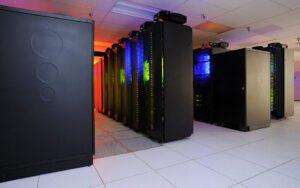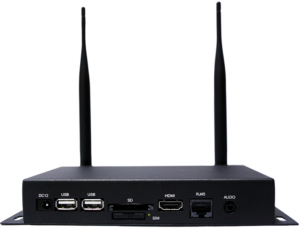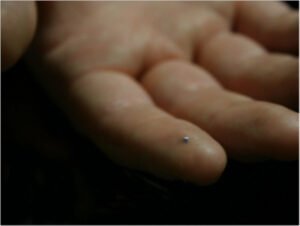Swiftsure’s Bruno Riegl discussed with RFID Journal the planning and implementation of Qatar University’s RFID-based asset tracking and management system. Read below about the challenges and successes in meeting the university’s ever-growing resource management needs:
By Claire Swedberg
Nov 06, 2013—
Qatar University is already employing passive EPC Gen 2 ultrahigh-frequency (UHF) tags and readers to track 30,000 assets across most of the 40 buildings comprising its campus in Doha. This fall, the university plans to extend its use of the technology to track individuals and mail deliveries.

The
RFID deployment includes the installation of Impinj xPortal readers on stairways and doorways.
Initially, the school purchased the system—supplied and installed in 2011 by Verasset, a U.S.-based RFID solutions provider—to identify such assets as computer equipment and furnishings during audits. The solution not only ensures that the university maintains an accurate record of which assets are located in which areas, but also reduces the amount of time required to carry out an audit process, from several months down to approximately one week. The college’s business operations department will also use the solution to manage the equipment’s maintenance schedules.
Now the school hopes to utilize the technology to ensure that the proper mail is delivered quickly, and to provide location data regarding personnel passing through portals for safety purposes. In that way, the university will be able to track which individual takes which asset into or out of a particular building, as well as warn a person before he or she inadvertently enters a segregated area occupied by members of the opposite sex.
The asset-tracking deployment includes 920 Impinj xPortals—RFID portals made with Speedway R420 RFID readers and integrated Impinj dual linear phased-array antennas (see Impinj Releases Compact High-Performance EPC RFID Portal), as well as 50 Jamison RFID portals equipped with Impinj R220 readers and Laird antennas. The portals are installed at building entrances and exits, as well as at the doorways to each floor and dwelling area. The deployment also includes 10 Convergence Systems Ltd. (CSL) CS101 handheld readers, provided to staff members for auditing processes.
Initially, the school brought Verasset a list of assets to that included about 100,000 items, according to Adam Vinecombe, Verasset’s director of service delivery. The firm then worked with the university to reduce that number to 30,000 of the highest-value items, including heating, ventilation and air conditioning (HVAC) units, in addition to laptops and other computers. A variety of EPC Gen 2 UHF RFID tags—provided by such vendors as Confidex, Omni-ID and Emerson and Cuming (a Laird Technologies company)—were required, depending on each asset’s material (such as steel or plastic) and location. For example, HVAC units on the buildings’ roofs (which are tracked for maintenance services) could experience temperatures above 130 degrees Fahrenheit (54 degrees Celsius), which meant a more ruggedized Emerson and Cuming Metaltag Flex tag was necessary, as well as special epoxy to adhere it to the asset (other adhesives would simply not hold up in extreme temperatures). Due to the locations of some buildings and the portals mounted within, Verasset also installed TRENDnet Wi-Fi routers so that portals could transmit read data to the back-end database, while some portals were cabled via an Ethernet cable for a Power-over-Ethernet (PoE) connection.
The school supplied its own Oracle-based software to manage inventory read data, with Microsoft BizTalk to link RFID read data to the inventory software.

The xPortal contains an
RFID reader and antennas integrated in a compact unit measuring 30.5 inches by 8.75 inches by 2 inches.
Verasset sent 10 of its employees to apply the tags onsite—a process that lasted four weeks—and record each tagged asset into the university’s software. With that task completed, each time an asset passed through one of the portals, the software is updated to indicate where that item was last recorded as being.
Because the university is growing quickly (its student population increased by 20 percent during the past year), it is now considering other ways in which the system can be used to boost efficiency and better manage its operations, explains Bruno Riegl, senior project manager.
Verasset has now provided the school with evaluation tags for badges that personnel can wear while moving around the campus. Each badge has a built-in UHF RFID inlay (for the purpose of location tracking) and high-frequency (HF) RFID inlays (for use in access control), and incorporates an HID Global DESFire EV1 card containing a UHF inlay made with an Impinj Monza 4QT RFID chip, with a unique ID number encoded on it that could correspond to that specific employee.
As the staff member passes through a UHF RFID portal, the software residing on the college’s database links that ID to the individual and stores a record of that movement. In that way, the university can collect data that could be accessed in the event of an emergency—such as identifying which people are within a given building if a fire or other catastrophe occurs. In addition, the readers could be linked to audible or visual alerts that could be triggered at the portal for an individual entering a restricted area. One concern for the university is ensuring that staff members do not inadvertently enter a restricted area containing those of the opposite sex, as buildings and classes are segregated. For example, the library has separate wings for females and males, in which students and faculty members conduct research. If a male individual attempts to walk into an area designated for females, he could view an alert on a monitor at the portal correcting his mistake.
In addition, the school is testing passive UHF RFID tags on plastic mail-sorting trays in which mail is transported from a mailroom to recipients. The unique ID number encoded on the tray’s tag could be linked to building 2A, for instance, and the mailroom staff would fill that box with letters destined only for that building. As a mail deliverer arrived at the building, the existing RFID reader portal would capture the tray tag‘s ID number and confirm that the box was dedicated to that building, and then either update the electronic record to indicate the mail was received at that time, or issue an alert (either audible or visual) to the mail staff at the portal, indicating that the box was being delivered to the wrong building.
Tagging is currently underway as the university continues to construct new buildings, Riegl reports. Items such as chemicals or equipment for the new research-and-development and biohazard laboratories are still being fitted with passive UHF tags. If employees carry badges, the school will be able to link specific individuals with the assets being removed.

Bruno Riegl, Senior Project Manager
In the future, Riegl says, the university may opt to use the asset-tracking solution to monitor maintenance as well, by allowing the maintenance staff to locate an asset using a handheld reader, and then enter data indicating which services are being provided related to that item. If a worker removes the asset from the building, that event would also be stored, based on a read from one of the portals.
According to Riegl, Verasset faced a variety of challenges related to this installation, including navigating the documentation requirements for customs and other agencies to bring equipment into Qatar. Having successfully acquired all of the necessary paperwork, inspections and certifications from multiple agencies, he says, Verasset has become an expert in dealing with the process of implementing a technology solution in a country such as Qatar.
Additional challenges were created by the widespread nature of the installation in buildings that are, in some cases, located in remote areas of the campus, as well as by the harsh weather, Riegl says. The university thus worked with Verasset to improve its own Wi-Fi network, to ensure that data culled from wireless readers could be received by software on its database.
![]() March 13, 2019 – Seattle – Swiftsure Group executive Bruno Riegl will host a panel discussion about sensor-based resource management March 22 at Data Center World in Phoenix. Also leading the panel will be Tim Buckley from Swiftsure affiliate company rfidCollect and Andrew Jimenez, VP Technology at Anixter.
March 13, 2019 – Seattle – Swiftsure Group executive Bruno Riegl will host a panel discussion about sensor-based resource management March 22 at Data Center World in Phoenix. Also leading the panel will be Tim Buckley from Swiftsure affiliate company rfidCollect and Andrew Jimenez, VP Technology at Anixter.









